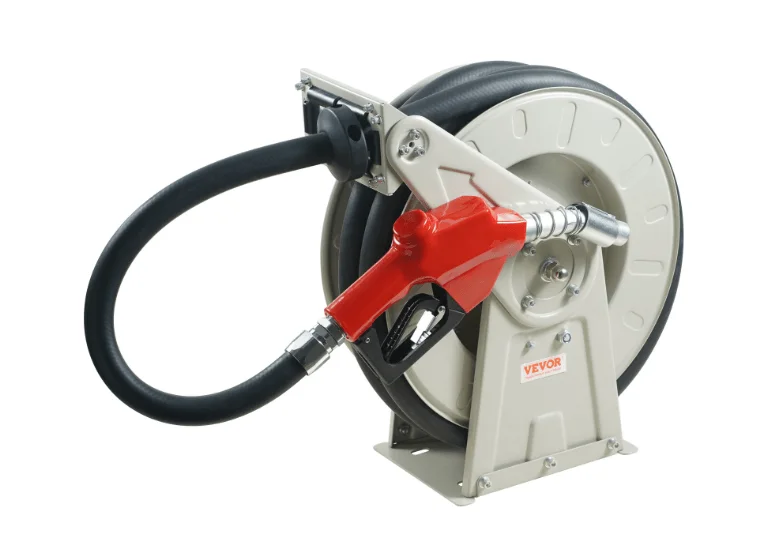In fuel management, having the right equipment is essential. Among these critical components is the diesel fuel hose reel.
Whether you own a small farm or operate a construction site, a reliable diesel fuel hose reel can make a difference.
But what exactly is a diesel fuel hose reel, and why is it so important? In this guide, we’ll explore everything you need to know about choosing the perfect diesel fuel hose reel for your needs.
Stay with us till the last line as we will discuss key features to look for, how to install and maintain your hose reel, and why VEVOR’s offering stands out in the market.
Table of contents
- Why You Need a Diesel Fuel Hose Reel
- Common Applications of Diesel Fuel Hose Reels
- Key Features to Look for in a Diesel Fuel Hose Reel
- How to Install and Maintain Your Diesel Fuel Hose Reel
- Maintenance Tips
- Troubleshooting Common Issues
- Safety Tips
- VEVOR Diesel Fuel Hose Reel Review
- Frequently Asked Questions (FAQs)
Why You Need a Diesel Fuel Hose Reel
If you deal with diesel fuel and have ever asked yourself why you need a diesel fuel hose reel, it’s like you are hungry and asking why you need food. It isn’t just about having a fancy accessory—it’s a necessity.
Benefits of diesel fuel hose reel
Here are some key benefits:
Efficiency and Convenience
A hose reel makes dispensing fuel quick and organized, cutting down on downtime.
Safety
Properly storing hoses minimizes tripping hazards and potential fuel leaks, reducing the risk of accidents.
Longevity
Hose reels protect hoses from wear and tear, extending their lifespan and ensuring consistent performance.
Common Applications of Diesel Fuel Hose Reels
Diesel fuel hose reels are versatile tools used in various settings:
Agricultural Operations
Refuel tractors combine other farm equipment to keep everything running smoothly during the planting and harvesting seasons.
Construction Sites
Easy access to fuel keeps projects on schedule. It ensures heavy machinery stays operational, preventing costly delays.
Fleet Management
An efficient refueling system is essential for garages and service stations to keep all cars in service. It manages multiple vehicles like magic and reduces wait time.
Industrial Plants
Industries can easily maintain continuous operations with minimal interruptions with a reliable fuel supply.
Safety and Efficiency Considerations
Using a diesel fuel hose reel can significantly enhance both safety and efficiency in your operations:
Prevent Spills
Secure reeling and storage mechanisms help prevent fuel spills, which can be hazardous to the environment and personnel. This ensures a safer and cleaner workplace.
Reduce Manual Labor
Automatic reels reduce the physical effort required by operators, minimizing operator fatigue and the risk of repetitive strain injuries. This leads to a healthier workforce.
Enhance Workflow
Streamlined fuel dispensing processes lead to better time management and productivity. Efficient workflows mean tasks are completed faster and with fewer interruptions, improving overall operational efficiency.
Key Features to Look for in a Diesel Fuel Hose Reel
Durability and Build Quality
One of the first aspects to consider is the durability and build quality of the hose reel. Here’s what to look for:
Materials Used
Stainless Steel
Things seem to last forever, and stainless steel is one of those things. It does not rust or corrode, which makes it perfect for harsh environments, such as marine areas or industrial settings.
Heavy-Duty Plastic
never underestimate the power of heavy-duty plastic. It’s solid but light, making it an excellent option for jobs that don’t require extreme durability. it is easy to maintain and install. Furthermore, it’s budget-friendly, so you do not have to pay for arms and legs, and it still does the job.
Powder-Coated Steel
Powder-coated steel, why? This coating adds an extra layer of protection against the element, expanding its life span. Also, it is a go-to choice for playground equipment and outdoor railings.
Construction Techniques
Reinforced Seams
It is crafted to handle all of the wear and tear. Whether it’s a heavy-duty tarp or a piece of outdoor furniture, these seams are designed to withstand heavy use and keep everything intact.
High-Quality Bearings
They are engineered to provide smooth and efficient operation. These bearings significantly reduce maintenance needs, ensuring consistent performance over time.
Robust Mounting Brackets
These sturdy brackets are built for secure installation. They enhance stability during use, offer reliable support, and minimize the risk of detachment.
Hose Length and Diameter

Choosing the proper hose length is crucial for efficient fuel management. Here’s a quick guide based on typical applications:
| Hose Length | Ideal Use |
| Short Hoses (Up to 25 feet) | Ideal for small workshops or garages. |
| Medium Hoses (25-50 feet) | Suitable for agricultural or construction sites. |
| Long Hoses (over 50 feet) | Best for large industrial plants or fleet management. |
Importance of Hose Diameter
The diameter of the hose impacts the flow rate and pressure. Here’s what to consider:
Smaller Diameters (1/4 to 3/8 inch): Lower flow rates, suitable for light-duty applications.
Medium Diameters (1/2 to 3/4 inch): Balanced flow and pressure, ideal for most standard uses.
Larger Diameters (1 inch and above): High flow rates are necessary for heavy-duty industrial applications.
Reel Mechanism and Ease of Use
Manual vs. Automatic Reels
- Manual Reels: Require physical effort to wind the hose. Suitable for occasional use.
- Automatic Reels: Feature spring-driven or motorized mechanisms for effortless reeling. Ideal for frequent use.
Ease of Reeling and Unreeling
Look for features like:
- Smooth Operation: High-quality bearings for easy winding.
- Locking Mechanism: To secure the hose at the desired length.
- Swivelling Base: Allows for flexibility and ease of movement.
Compatibility and Flexibility
Compatibility with Various Fuels
Ensure the hose reel is compatible with different types of fuel, including:
- Diesel
- Gasoline
- Kerosene
- Flexibility and Mobility
Consider the mobility of the hose reel:
- Portable Options: For on-the-go fuel dispensing.
- Fixed Installations: For stationary fuel management systems.
- Swiveling Bases and Rotating Arms: For enhanced flexibility and reach.
How to Install and Maintain Your Diesel Fuel Hose Reel
Tools Required for Installation
Before initiating the installation, having some tools with you is essential. here are the tools you’ll need:
- Drill and drill bits
- Wrenches
- Screwdrivers
- Mounting hardware (bolts, screws)
Step-by-Step Installation Process
Select an Appropriate Location
- Choose a location that provides easy access to your fuel source.
- Ensure the mounting surface is strong enough to support the hose reel’s weight.
Mark the Mounting Points
- Hold the mounting bracket or hose reel in place.
- Use a pencil or marker to outline the mounting holes on the surface.
Drill Holes for Mounting
- Use a drill and appropriate drill bits to create holes at the marked points.
- Ensure the holes are sized to match the mounting hardware.
Attach the Mounting Brackets
- Secure the mounting brackets to the surface using bolts or screws.
- Use wrenches or screwdrivers to tighten the hardware firmly.
Mount the Hose Reel
- Align the hose reel’s mounting holes with the brackets.
- Insert bolts or screws to secure the hose reel to the brackets.
- Tighten the bolts or screws to ensure the hose reel is stable.
Connect the Hose to the Reel
- Attach one end of the hose to the inlet of the hose reel.
- Use wrenches to ensure the connection is tight and leak-free.
Prime the Hose Reel (if required)
- Follow the manufacturer’s instructions to prime the hose reel.
- Ensure the hose is correctly wound on the reel.
Test the Setup
- Dispense a small amount of fuel to check for leaks and smooth operation.
- Adjust the setup if necessary to ensure optimal performance.
Secure and Store the Hose
- Wind the hose onto the reel and engage the locking mechanism if available.
- Store any remaining tools and ensure the area is clean and safe.
Maintenance Tips
Regular Maintenance Schedule
- Weekly: Inspect the hose for wear and tear and clean the reel.
- Monthly: Check all connections for leaks and lubricate moving parts.
- Annually: Perform a thorough inspection and replace any worn-out components.
Troubleshooting Common Issues
- Leaks: Tighten connections and replace damaged hose sections.
- Reeling Problems: Lubricate bearings and check for obstructions.
- Pressure Issues: Ensure the hose diameter is appropriate for the application.
Safety Tips
Safe Handling Practices
- Always wear protective gear when handling fuel.
- Ensure the work area is well-ventilated.
- Follow manufacturer guidelines for hose reel operation.
Emergency Procedures
- Have fire extinguishers readily available.
- Know the location of emergency shut-off valves.
- Train employees on emergency response protocols.
Recommended For Your Project
VEVOR Diesel Fuel Hose Reel Review
Overview of VEVOR Diesel Fuel Hose Reel
If you’re searching for a reliable diesel fuel hose reel, VEVOR has one of the best options. These are designed to meet the needs of various industries and are known for their durability, ease of use, and advanced features.

Key Features and Benefits
Sturdy Construction
It is crafted from high-quality stainless steel to last, so you won’t have to worry about frequent replacements or repairs.
Automatic Reeling Mechanism
The automatic reeling mechanism makes the operation effortless—no more manual labor—just smooth, efficient reeling every time.
Versatile Compatibility
This hose reel isn’t just for diesel. It’s also compatible with gasoline and kerosene, making it a versatile addition to any setup.
User-Friendly Design
Installing and maintaining this hose reel is a breeze. It even has a swiveling base for added flexibility, so you can position it exactly where you need it.
Frequently Asked Questions (FAQs)
How do I choose the proper hose length?
It depends on your needs. Here are rough ideas:
- A hose up to 25 feet should do the job for small workshops.
- More extensive operations like agricultural or construction sites might need hoses between 25 and 50 feet.
- Industrial settings may require even longer hoses, over 50 feet.
Can I use a diesel fuel hose reel for other fuels?
Yes, many diesel fuel hose reels are compatible with other fuels, such as gasoline and kerosene. Always check the manufacturer’s specifications to be sure.
How do I prevent leaks and spills?
To prevent leaks and spills, regularly check the hose and connections. Tighten any loose fittings and replace damaged hose sections as soon as possible. Proper storage on the reel also helps minimize wear and tear.
What should I do if the reel mechanism fails?
If the reel mechanism fails, check for any obstructions or debris. Lubricate the moving parts and make sure all connections are tight. If issues persist, consult the manufacturer’s troubleshooting guide or contact their customer support.
Final Words
Choosing the right diesel fuel hose reel is crucial for efficient and safe fuel management. This guide covers everything you need to know, from critical features to maintenance tips. If you’re in the market for a reliable hose reel, consider the VEVOR Diesel Fuel Hose Reel for its durability, functionality, and ease of use.
Invest in the proper diesel fuel hose reel today and streamline your fuel management processes. For more information, visit VEVOR and explore our range of premium hose reels.





